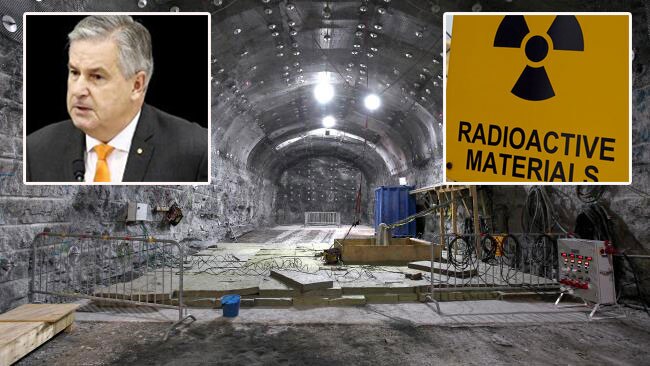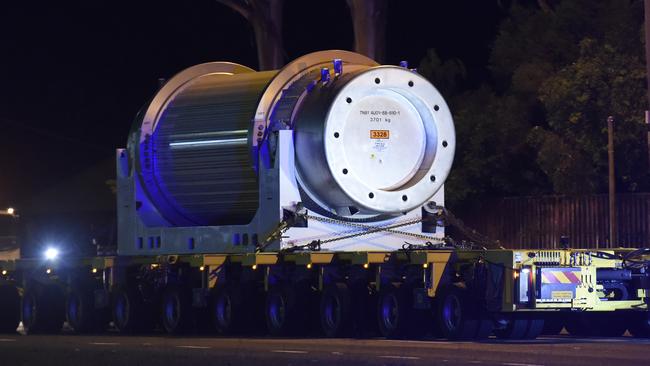Labor, Liberal unite to support high-level nuclear waste dump in South Australia
UNPRECEDENTED political support is being thrown behind South Australia becoming the global dump for high-level nuclear waste in return for a $445 billion bonanza.

SA News
Don't miss out on the headlines from SA News. Followed categories will be added to My News.
- REPORT: Nuclear waste dump would earn state $445 billion
- REACTION: Conservationists unite to fight ‘immoral’ dump
- ELECTRICITY: Nuclear power ‘not viable — for now’
- TRADE: SA’s uranium exports could triple by 2040
- FUTURE: Could we combine uranium mining with fuel leasing?
UNPRECEDENTED political support is being thrown behind South Australia becoming the global storage facility for high-level nuclear waste in return for a $445 billion bonanza.
Forging a historic united front on a decades-old issue of bitter division, Labor Premier Jay Weatherill and Liberal federal Resources and Energy Minister Josh Frydenberg are encouraging debate on a Royal Commission proposal, unveiled on Tuesday, for SA to store and dispose of hundreds of thousands of tonnes of spent nuclear fuel and waste.
Both Mr Weatherill and Mr Frydenberg are neither endorsing nor opposing the proposal for a high-level international dump — emphasising that it must not proceed without community support.
Nuclear Fuel Cycle Royal Commissioner Kevin Scarce on Tuesday recommended multibillion-dollar revenue from storing the world’s high-level waste be ploughed into a State Wealth Fund, which his report estimates would generate more than $6 billion annually for at least 70 years — totalling about $445 billion.

A process for selecting a site will be announced within weeks in the Royal Commission’s final report on May 6, although criteria detailed suggest the state’s Far North is the most likely location.
About 1500 fulltime jobs — peaking at up to 5000 — would be created during a 25-year construction of the deep underground waste repository, along with 600 fulltime jobs once operational.
“It would be a world-class facility producing a solution that the globe needs and benefiting the South Australian community,” Rear Admiral Scarce told The Advertiser.
He pointedly rejected the description of the proposed facility as a “dump”, saying a repository would be a sophisticated, specifically engineered site to prepare used fuel for disposal.
DANIEL WILLS’ ANALYSIS
Incredible amount of wealth for SA
Breathtaking vision for our state
Bipartisan state and federal backing to debate a high-level dump is an unprecedented break from decades of bickering, which scuttled previous plans for both high-level and low-level nuclear waste repositories. This included a fierce campaign spearheaded by former premier Mike Rann in 2004, blocking a federal Coalition proposal for a national low-level dump at a sheep station near Woomera.
Visiting Adelaide on Tuesday, Labor Opposition Leader Bill Shorten did not rule out support for increasing nuclear waste storage when questioned about the findings.
“Federal Labor has always said that we do support safe storage of low grade nuclear waste,” Mr Shorten said, referring to the current storage of Australian medical nuclear waste.
“What we need to make sure, if it’s going to be higher levels of storage ... storing other people’s nuclear waste, is that there’s an economic benefit, that it meets all the environmental concerns, that there’s community support.
“It’s been a good first step to cast proper light ... on something that has been put in the ‘too hard basket’.
“We need to have a sensible analysis, not inflamed tabloid headlines, and just work through the issues. That’s what Australians want.”
Mr Shorten said he supported holding a Royal Commission into the issue.
“The tentative findings are an important addition to the knowledge about nuclear waste storage in this country,” he said.
Responding to the Royal Commission’s 44-page “tentative findings” report, Mr Weatherill declared it contained some exciting proposals for SA and vowed to produce a formal response by the end of the year.
“This is a test of our democracy. Can we take a controversial issue, which is about the long-term future of our state, and consider it in a respectful and intelligent way and reach a wise judgment?” he said.
“I’m prepared to entertain the idea of a deeper involvement of SA in the nuclear fuel cycle.
“Certainly, there needs to be a political consensus. That’s a precondition. Both major parties, at a national and state level reaching a view about that, I would imagine, would be a minimum.”
Mr Frydenberg said he welcomed discussion of new and expanded industries that could create jobs, growth and significant revenue for Australia, also stressing that community and bipartisan consensus was critical.
“I don’t think you do anything purely for economic means. You do it for sound policy means, which means you take into account, just by definition, safety issues,” he told The Advertiser.
“You would only take this step forward if you were very confident that the safety and the security can be appropriately dealt with.”
Mr Frydenberg said the Royal Commission’s recommendation of a high-level repository was separate and distinct from the federal process to establish a national low-level dump, for which three of six proposed sites are in SA — two near Kimba and one north of Port Augusta.
State Opposition Leader Steven Marshall said a nuclear dump would not be the silver bullet for a jobs crisis delivered by Labor.

Federal Labor leader Bill Shorten deflected questions on the report by saying he would not comment further until he had read the recommendations.
Conservation SA chief Craig Wilkins said SA could do better than saying “the best we can do is accept the worst the world has got”, branding the nuclear industry “expert” at overstating benefits and radically understating costs.
The Royal Commission proposes storing about 138,000 tonnes of international used nuclear reactor fuel and recommends funding the facility by accepting an initial $2 billion fee for a first waste batch, stored in secure above-ground containers, from the late 2020s.
Waste would then be stored for thousands of years in a secure repository below about 500m of bedrock, in multiple-layer containers. A dedicated port, airport and freight rail line would support the facility.
The tentative findings report is open for public consultation until Rear Admiral Scarce, a former state governor, hands down his final report in May.
The Royal Commission also found:
NUCLEAR power generation should be considered as part of Australia’s future needs for low-carbon electricity but was uneconomic for SA in the short-term.

MANAGING social, environmental, safety and financial risks is “not beyond South Australians”.
LONG-TERM political decision-making and bipartisan federal and state support is vital.
Speaking to The Advertiser after his report’s release, Rear Admiral Scarce said there was no evidence to suggest a nuclear industry would spoil SA’s clean and green image.
“In fact, when we go overseas and go to countries like France and England, there’s no evidence that the nuclear industry is impacting on their clean, green image,” he said.
“There’s no evidence to suggest that in France, food and wine isn’t treated with global respect.”
Rear Admiral Scarce said his final report would have a significant section on next steps, including processes for community and social consent, along with site selection for a waste repository.
He conceded some areas of the state would be excluded from consideration for a dump site, because, for example, they were not in an arid climate zone or had too much groundwater.
“The geology is critical. It has to be seismically stable. That will rule out a lot of areas up and down the (Mt Lofty and Flinders) ranges, for example,” Rear Admiral Scarce said.
KEY FINDINGS
* South Australia can safely increase its participation in the nuclear fuel cycle.
* Community agreement is fundamental to any increase.
* Some activities are commercially viable, others are not.
* Waste management the big winner — able to create a wealth fund of about $445 billion in 70 years, create 9600 jobs and underpin financing of a new port, railway and airport.
* Future demand for uranium and nuclear power inextricably linked with the effort to combat climate change — at national and global level.
PARTS OF THE CYCLE
* Exploration, extraction and milling — potential to grow existing industry but not the biggest opportunity.
* Further processing — unlikely to be a business case for at least a decade because world is oversupplied with processing capacity.
* Nuclear power — not viable in current electricity market and carbon price settings. However, likely to change and would be wise to prepare now.
* Waste management — SA’s unique set of geology, skills, population distribution, arid climate zones, mature and stable political democracy and other factors put the state in pole position globally to reap huge economic benefits for decades.
BY THE NUMBERS
* 252 submissions received by the commission, consisting of 2,071,874 words.
* 2100 hours of hearings involving 128 witnesses, including 37 international experts.
* More than 60 information sessions in metropolitan, regional and Aboriginal community settings.
* Waste management slated to generate $257 billion in revenue, leading to a $445 billion State Wealth Fund.
* 16,000 years — cumulative operation so far of nuclear power plants.
* 2C — the target globally for maximum increase in average temperature but which humanity will fail to meet unless more radical action in taken than what was pledged at Paris.
WHAT NEXT?
* Royal Commissioner Kevin Scarce says he encourages the community to challenge the facts in the tentative findings.
* The commission has begun a five-week feedback period, commencing with a week of public presentations across the state. Public responses are invited until 5pm, March 18.
* Documents are available at www.nuclearrc.sa.gov.au
* The commission aims to deliver a final report on May 6.
* The State Government will take control of the process from May 6, with Premier Jay Weatherill promising a period of “deliberation” until August.
* The Cabinet, which has yet to declare a position, will then prepare a case to take to parliament before the end of the year.
* Mr Weatherill said he did not want to rush any decisions nor get caught up in federal election cycle issues.
THE WASTE MANAGEMENT PROCESS
* Fuel from a nuclear reactor remains dangerously radioactive after initial use.
* Once extracted from the reactor, fuel rods are cooled in a pool for about ten years.
* Then into dry storage for up to 40 years.
* To prepare for disposal, fuel rods are cast into metal canisters.
* Canisters inserted into copper overpacks to prevent corrosion.
* These would be shipped to a new port in SA and railed to the waste management site.
* In the interim, canisters would be stored above ground while revenue from their receipt would go into building an underground facility.
* Shafts and tunnels would be dug up to 500m below ground, deep into stable bedrock.
* Canisters would go into holes which would have Bentonite clay packed around them. Bentonite clay has self-sealing properties and low permeability.
* Holes and tunnels then backfilled with rock to make them secure for hundreds of thousands of years.
* Would take 20-25 years to fully construct the waste management site.


